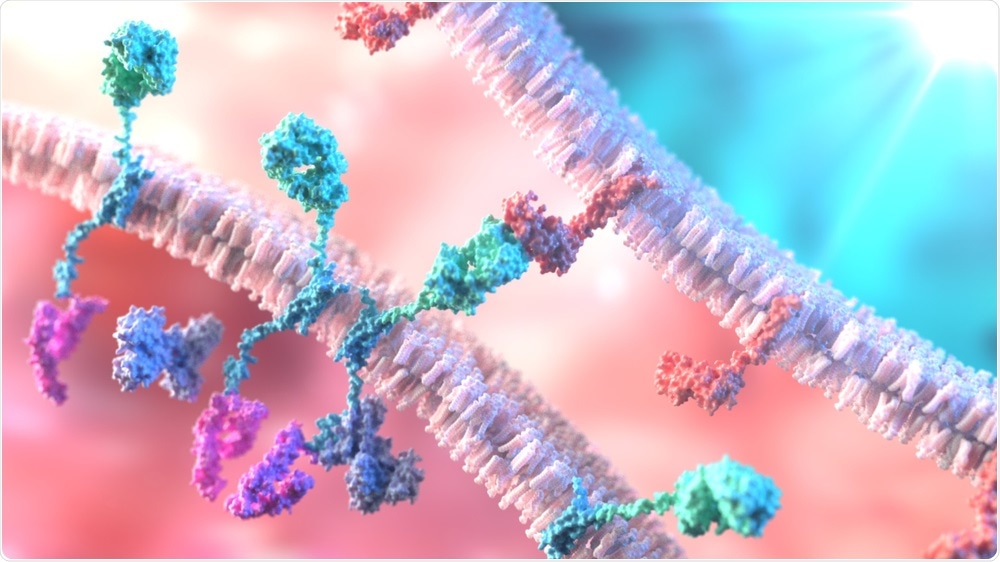Scientists from the Babraham Institute, United Kingdom and VIB-KU Leuven, Belgium, came up with two solutions that can overcome a major clinical limitation of immune cell therapies. The researchers chose mice as their model. The findings were published recently in the journal Science Immunology.

Cell Therapy. Image Credit: Alpha Tauri 3D Graphics/Shutterstock.com
Regulatory T cells are capable of treating autoimmunity and inflammatory diseases; however, they can switch from a protective to damaging function. Determining the unstable regulatory T cells and understanding how they can be cleared from a cell population offers a way forward for regulatory T cell transfer therapy.
Cell therapy involves purifying cells from a patient, growing them in cell culture to enhance their properties, and reinfusing them back into the patient.
The leading use of cell therapy is to improve T cells so that they can attack and kill a patient's cancer, however, the incredible versatility of the immune system means that, in principle, we could treat almost any immune disorder with the right cell type.”
Adrian Liston, Professor and Leader, Immunology, Babraham Institute
“Regulatory T cells are particularly promising, with their ability to shut down autoimmune disease, inflammatory disease, and transplantation rejection. A key limitation in their clinical use, however, comes from the instability of regulatory T cells—we just can't use them in cell therapy until we make ensure that they stay protective,” adds Professor Liston on T cell’s therapeutic potential.
T cells are of different types and each has a unique function in our immune system.
While most T cells are inflammatory, ready to attack pathogens or infected cells, regulatory T cells are potent anti-inflammatory mediators. Unfortunately, this cell type is not entirely stable, and sometimes regulatory T cells convert into inflammatory cells, called effector T cells.”
Susan Schlenner, Professor, University of Leuven
“Crucially, the converted cells inherit both inflammatory behavior and the ability to identify our own cells, and so pose a significant risk of damage to the system they are meant to protect,” adds Schlenner.
The first major finding of this study highlights that once regulatory T cells turn inflammatory, they are resistant to return to their useful previous state. Hence, researchers should identify a way to eliminate the risky cells from any therapeutic cell populations, which leaves behind the stable regulatory T cells.
A comparison of unstable and stable cells helps the scientists identify molecular markers that pinpoint the cells at risk of changing from being regulatory to inflammatory. These markers can be applied to purify cell populations before they are used for treatment.
Besides cell purification, the scientists identified that exposure of regulatory T cells to a destabilizing environment clears the unstable cells from the mixture. Under such conditions, the unstable cells are activated to convert into inflammatory cells, enabling the scientists to purify the stable cells that remain.
The work needs to be translated into human cell therapies, but it suggests that we might be best off treating the cells mean. Currently, cell culture conditions for cell therapy aim to keep all the cells in optimal conditions, which may actually be masking the unstable cells. By treating the cultures rougher, we may be able to identify and eliminate the unstable cells and create a safer mix of cells for therapeutic transfer.”
Adrian Liston, Professor and Leader, Immunology, Babraham Institute
According to Dr. Steffie Junius, the study lead author, “The next stage in the research is to take the lessons learned in mice and translate them into optimal protocols for patients. I hope that our research contributes to the improved design and allows the development of effective regulatory T cell therapy.”
Dr. Junius performed the research as a Ph.D. student at the University of Leuven.
Creating a keen process to enhance cell population stability in mice enables researchers to lay the groundwork for better immune cell therapies in humans; however, the methods detailed in the research would require validation in humans before they were used in cell therapy trials.
Dr. Timothy Newton remarked, “This research makes a significant impact on regulatory T cell therapeutic development by characterizing unstable subsets of regulatory T cells that are likely to lose their desirable therapeutic qualities and become pro-inflammatory.”
“The successful identification of these cells is of great importance when designing manufacturing strategies required to turn potential T cell therapeutics into practical treatments for patients of a wide range of inflammatory disorders,” adds Dr. Newton on the translational potential of the research.
Dr. Newton is the CEO of Reflection Therapeutics, a Babraham Research Campus-based company designing cell therapies against neuro-inflammation. Dr. Newton was not involved in the research.
Source:
Journal reference:
Junius, S., et al. (2021) Unstable regulatory T cells, enriched for naïve and Nrp1neg cells, are purged after fate challenge. Science Immunology. doi.org/10.1126/sciimmunol.abe4723.